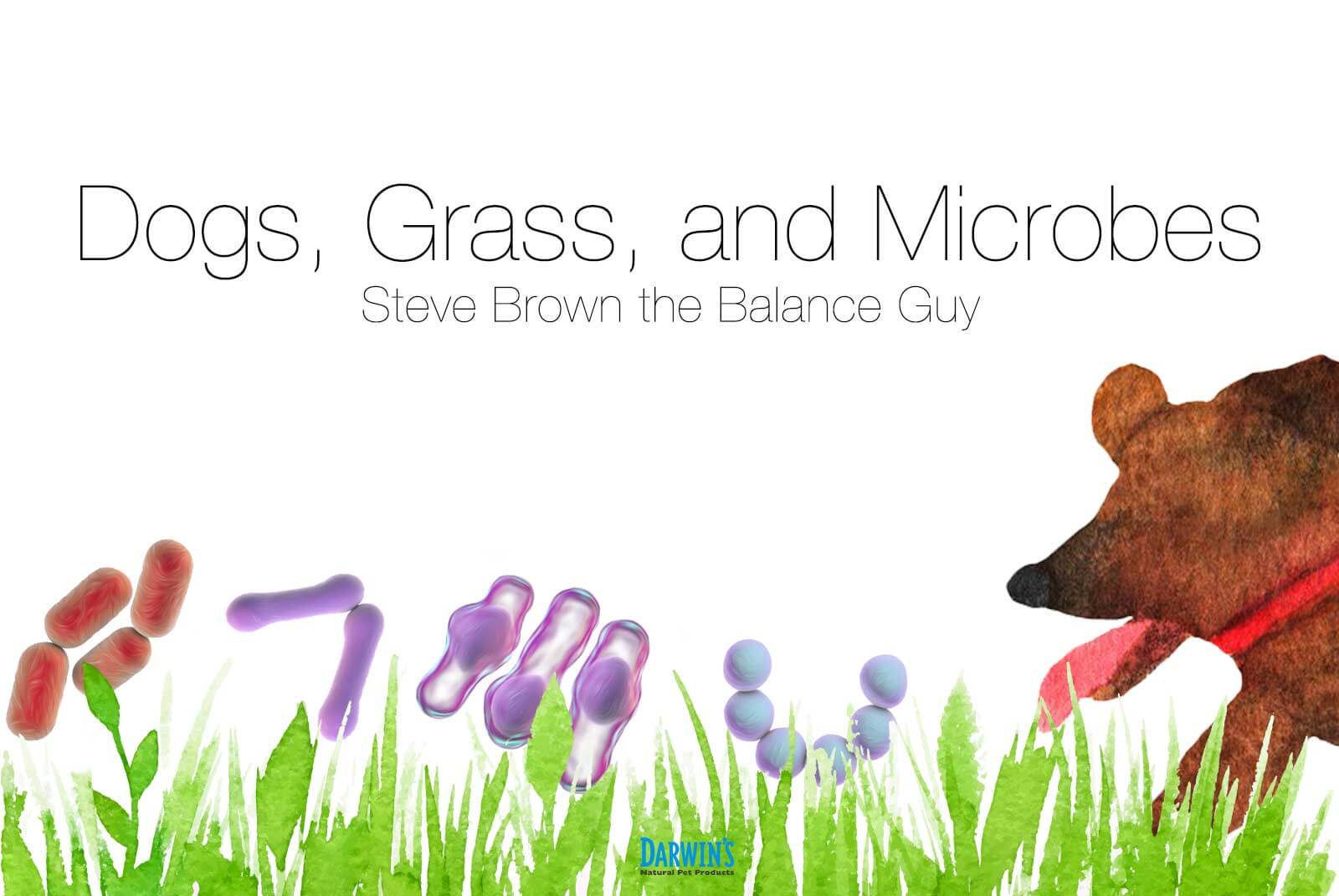Dogs, Grass, and Microbes
2/9/17

By Steve Brown
Last Updated on
Dogs and Grass
Google “why dogs eat grass” and you’ll find 2,000,000 plus articles listing reasons from eating grass to compensate for missing nutrients in their diets to eating grass when they feel nauseated. I think these explanations have some validity, however, they do not tell the whole story.
Recent studies suggest that dog-eating-grass behavior is primarily driven by the dog’s gut microbes that dine on the types of dietary fiber found in grass. The gut microbes that feed on dietary fiber are generally beneficial, and when fed well, help produce a healthy microbial population in the dog’s gut.
Healthy Gut Microbes
Microbes are microscopic organisms, primarily bacteria, living on the skin and mostly in the guts of all mammals. There may be 100 trillion microbes in the dog’s gut, the vast majority of which are not harmful and many of which are beneficial to their hosts. While the size of microbes vary, typically one teaspoon will contain 5 – 10 trillion bacteria. Every time the dog breathes she’ll inhale millions of bacteria, probably thousands of different species.
A healthy gut microbe population is essential for good mental and physical health. Fresh, healthy, living grass is rich in a variety of dietary fibers and other nutrients and is food for the dietary-fiber-eating microbes in the dog’s gut. The vast variety of dietary fiber eating microbes help produce a healthy gut, providing a variety of health benefits, including literally taking up a lot of space in the gut, preventing unhelpful or pathogenic microbes from getting a foothold.
Grass-eating Microbes
Different species of microbes thrive on different kinds of food. They can prompt their hosts to eat more of the food they depend on so they can multiply. (My gut microbes must thrive on chocolate!)
The grass-eating microbes send signals to the dog’s brain saying, “eat grass.” When the dog eats grass, the microbes send chemicals such as dopamine saying, “thank you.”
Sounds crazy, doesn’t it? Microbes in the gut affecting the desires of a dog? But that’s the way life is, and it happens to us and all mammals as well. This is a fascinating new science, especially important for those studying the behavior of dogs, cats, and humans. In our guts, bacteria make some of the same chemicals that our brain neurons use to communicate with one another, such as dopamine and serotonin. And they are able to deliver them to the brain.
Because they have the gut microbes that dine on grass, passed to them by their mothers, eating grass is normal behavior among wolves and other wild canides. A 2009 dog study in the Journal of Veterinary Behavior found that puppies were more likely to eat grass if their mothers did while nursing.i
Dietary Fiber
Most dogs have gut microbes specializing in consuming various types of dietary fiber. These microbes are based partially upon their recent diets and the diets of their mothers. Dry foods often contain purified forms of fiber, which some studies suggest are not as effective in promoting good gut health as are dietary fibers from vegetables.ii
So dry dog food feeders: add a variety of leftover vegetables, finely ground or cooked and let them eat clean grass. Feed their good microbes!
“Microbes have the capacity to manipulate behavior and mood through altering the neural signals in the vagus nerve, changing taste receptors, producing toxins to make us feel bad, and releasing chemical rewards to make us feel good,”iii
Want to explore this exciting topic further? I highly recommend the wonderful new book by Ed Yong. “I Contain Multitudes, The Microbes Within Us and a Grander View of Life.”
i Maternal influence on grass-eating behavior in puppies Samantha J. Bjone, Wendy Y. Brown, Ian R. Price. Journal of Veterinary Behavior Volume 4 Issue 2, pp97-98 March 2009.
ii University of Michigan Health System. “High-fiber diet keeps gut microbes from eating the colon’s lining, protects against infection, animal study shows.” ScienceDaily. ScienceDaily, 17 November 2016.
iii University of California, San Francisco (UCSF). “Do gut bacteria rule our minds? In an ecosystem within us, microbes evolved to sway food choices.” ScienceDaily. ScienceDaily, 15 August 2014.

Steve Brown is a dog food formulator, researcher, and author on canine nutrition. In the 1990s he developed one of the leading low-calorie training treats, Charlee Bear® Dog Treats, as well as the first AAFCO-compliant raw dog food. Since 2003 he has focused on research and education. He is the author of two books on canine nutrition (See Spot Live Longer, now in its 8th printing, and Unlocking the Canine Ancestral Diet (Dogwise Publishing, 2010); and a 40-page booklet, See Spot Live Longer the ABC Way.



